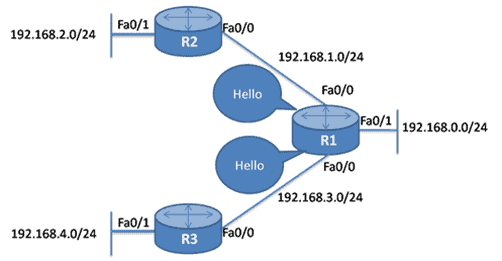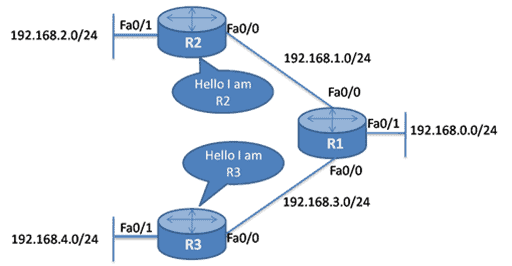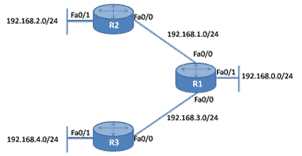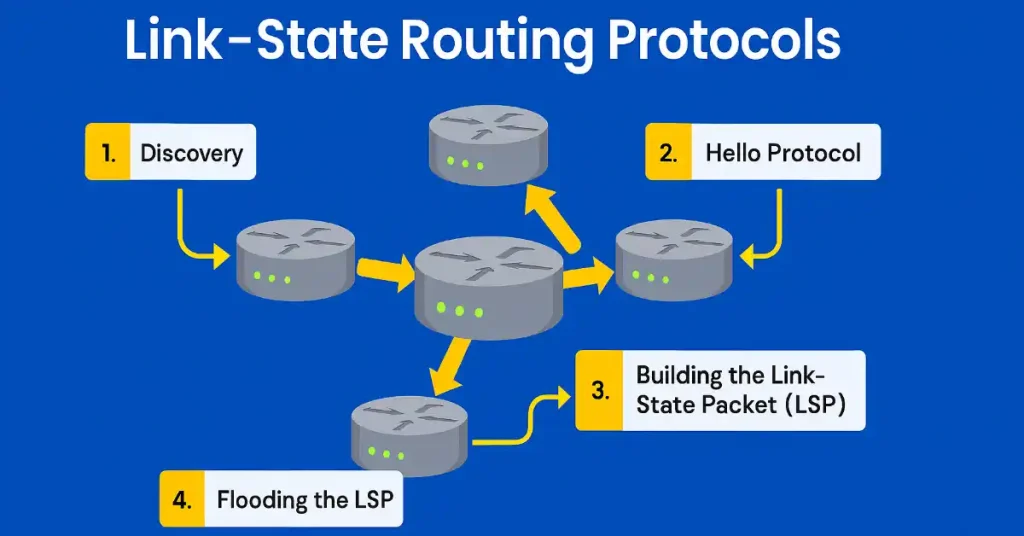Link-state routing protocols are also known as shortest-path first protocols. They maintain a complete picture of all the routers running a link-state routing protocol in the complete network. All routers running a link-state routing protocol originate information about themselves and their directly connected routers, links, and the state of those links as multicast messages.
The link-state router tries to maintain a complete network topology by updating itself whenever a change occurs. Link-state routing protocols are based on the Shortest Path First (SPF) algorithm to find the best path to a destination. The shortest Path First (SPF) algorithm is also known as the Dijkstra algorithm. OSPF is an example of a Link-State Routing Protocol.
Link-State Routing Process
The link-state process is identical for OSPFv2 (IPv4) and OSPFv3 (IPv6). Below, we outline the steps with examples.
Link and Link-State Discovery
Link and Link-state are the first steps in the routing process. Each router learns about its links and directly connected networks. When a router interface is configured with an IP address and subnet mask and is also in the state of no shutdown, it becomes part of that network. Refer to the topology in the Figure below. R3 has just been added to the network, and the IP addresses on the router interface are not configured yet; only the physical connectivity has been done. So, the router is not part of Link-State.
The network administrator now configured the IP addresses of the router interfaces connected to R2 and R5 and changed the state of the interfaces from shutdown to no shutdown. As they become active, R3 learns about its own directly connected networks. Without any routing protocols, these directly connected networks are now entries in the routing table.

The router’s interfaces must be accurately configured with IP addresses and subnet masks, and the link must be in the state of no shutdown before the link-state routing protocol can learn about a link. Also, like distance vector protocols, the interface must be included in one of the network router configuration statements before participating in the link-state routing process.
Link-state routers have direct information from all their neighbor routers. Each router originates information about itself, its directly connected links, and the state of those links. This information is passed around the network from router to router, and each router makes a copy of it without changing it. So, every router gets identical information about the internetwork, and each router will independently calculate its best paths.
In the reference topology, the R3 link to its directly connected networks is:
- FastEthernet 0/0 – 192.168.2.0/24
- FastEthernet 0/1 – 192.168.3.0/24
The link-state information includes the following:
- The interface’s IPv4 address and subnet mask
- The type of network, such as Ethernet or a Serial link
- The cost of that link
- Any neighbor routers on that link
The link state of R3 is the following:
Link1
Network: 192.168.2.0/24
IP address: 192.168.2.1
Type of network: Ethernet
Cost of that link: 10
Neighbours: None
Link2
Network: 192.168.3.0/24
IP address: 192.168.3.1
Type of network: Serial
Cost of that link: 64
Neighbours: None
Hello Protocol
The second step in the link-state routing process is the responsibility of meeting with neighbors on directly connected networks. Routers with the link-state routing protocol use a Hello protocol for establishing and maintaining router-neighbor relationships. A neighbor is any other router enabled with the same link-state routing protocol. The link-state routing protocol uses Hello packets for neighbour discovery and also for recovery.

The protocol continues exchanging Hello packets between two adjacent neighbors and serves as a keep-alive function to monitor the neighbor’s state. Suppose any router stops receiving Hello packets from a particular neighbor. This neighbor is considered unreachable, so the link-state protocol clears this router from adjacency.

Now refer to Figure 1 above, R1 sends Hello packets to all its interfaces when the administrator configures it, to discover the link-state neighbours .R2 and R3 respond to the Hello packet with their own Hello packets, as these routers have been configured with the same link-state routing protocol as shown in Figure 2. The FastEthernet 0/0 interface has no neighbors. So R1 did not receive any hello on this interface; therefore, it does not continue with the link-state routing process steps for the FastEthernet 0/0 link.
OSPF Hello Packet
After the primary exchange of Hello Packet, the routers add each other to their Neighbor Tables. The Neighbour table is the list of connected OSFP-enabled routers. Hello, packets are not recorded in the OSPF database, but if the hello packet has not been received from a particular neighbor for 40 seconds. The link-state routing protocol marked this particular neighbor as down. For example, OSPF will not take any notice if a link goes down for 20 seconds and again comes back to up status.
If a link goes down from a minute to half an hour, OSPF floods an LSA when it goes down and another LSA when it is up again. If a link is down for over half an hour, LSAs originated by remote routers begin to age out. When the link returns, all these LSAs will be flooded again. If a link is down for over an hour, any LSAs originated by remote routers will have aged out and been flushed. The link will be like a new OSPF route when it comes back up.
Building the Link State Packet (LSP)
The third step in the link-state routing process is building the link-state packet (LSP) containing the state of each directly connected link. It carries the information a network router generates in a link-state routing protocol that lists the router’s neighbors. It is a datagram determining the names of routers, including the cost or distance to any neighboring routers and linked local networks. It can also choose a new neighbor in case of link failure. The LSP also determines what the new neighbor is if a link fails and the cost of changing a link if required.
LSPs are queued for transmission and must time out at about the same time. The network is used to distribute the LSP, but cannot use the routing database. When a router has established adjacencies to other routers, it can build its LSP containing the link-state information about its links. Now refer to the figure below. The LSP from R1 should contain the information like the following:
- R1; FastEthernet network 192.168.0.0/24; Cost 1
- R1 -> R2; Serial point-to-point network; 192.168.1.0/24; Cost 1
- R1 -> R3; Serial point-to-point network; 192.168.3.0/24; Cost 1

Flooding LSP
After building the LSP, each router floods the LSP to all neighbours in the link-state routing process. This is the fourth step in the link-state routing process. The neighbor routers receive the LSP and save it in the database. All routers in the same routing area flood the link-state information to each other.
When a router receives the LSP from any of its interfaces, it immediately sends that LSP out to all interfaces except the receiving interface. This process continues from router to router in the same area until all routers receive the LSP. When flooding LSP is completed, then the link-state routing protocol calculates the SPF algorithm; thus, the link-state routing convergence speed is very high.
The routers do not send LSPs periodically like the hello packet. They are only sent during the initial startup of the routing protocol on the router. After that, the LSPs are needed to flood when network changes occur in the topology. They are also required when a network breakdown occurs or after the network comes back.
The LSPs also included information, such as sequence numbers and aging information, to help manage the flooding LSP process. Each router uses this information to determine if it has received the LSP from another router or has new and updated information than the LSP already contained in the link-state database. This process allows a router to keep only the most current information in its link-state database. Suppose we discussed the topology in the previous lesson, building the Link State Packet. The R1 will flood the LSP packet to all its interfaces containing the following data.
- R1; FastEthernet network 192.168.0.0/24; Cost 1
- R1 -> R2; Serial point-to-point network; 192.168.1.0/24; Cost 1
- R1 -> R3; Serial point-to-point network; 192.168.3.0/24; Cost 1

Building the SPF Tree
The routers in the same area use the link-state database and SPF algorithm to build the SPF tree. For example, in the figure below, R1 builds the SPF tree using the link-state information from all other routers. The SPF algorithm reads the router’s LSP to recognize networks and the link costs.

In the first step, R1 identifies its directly connected networks and their costs. After identifying the directly connected network, R1 begins identifying unknown networks from R2 and R3. Then, the SPF algorithm calculates the shortest paths to reach each network.
The SPF algorithm then calculates the shortest paths to reach each network. Each router in the area builds its own SPF tree separately from all other routers. To ensure accurate routing, the link-state databases used to construct those trees must be identical on all routers.
Building the Link-State Database
Link-state database building is the last step in the link-state routing process. Each router in the link-state uses the database to build a complete map of the topology and computes the best path to each destination network. All routers receive LSPs from every other link-state router in the same routing area. the
These LSPs are stored in the link-state database. Each router maintains a separate link-state database for every area to which it belongs, in case more than one area is configured in the network. The link-state database is also referred to as the topological database, and routers belonging to the same area have the same topological database for the area.
The databases for each area are always processed separately and calculate the link-state shortest path separately for each area and the topological database. The shortest path is flooded throughout the respective area only. The area database built of router links advertisements, network links advertisements, and summary link advertisements included external routes in all non-stub area databases.
Summary of Link-State Process
- Every router in an OSPF area will complete the following link-state process to exchange a state of convergence:
- Each router learns about its own directly connected networks and Links by detecting the interfaces in the upstate.
- All routers are responsible for “saying hello” to their neighbors on directly connected networks.
- Each router builds a Link-State Packet (LSP) containing the state of each directly connected link—the LSP contains neighbor, neighbor ID, link type, and link bandwidth.
- Each router floods the LSP to all neighbors. Those neighbors store all LSPs received in a database. They then flood the LSPs to their neighbors until all area routers have received the LSPs. Each router stores a copy of each LSP received from its neighbors in a local database.
- Each router floods the LSP to all neighbors, storing all LSPs received in a database.
- All routers use the database to build a complete topology map and calculate the best path to each destination network using Dijkstra’s Algorithm.
Important Terms of Link-State Protocol
Topological database – It is a set of information collected from LSAs.
SPF algorithm– The shortest path first (SPF) algorithm is used to calculate the SPF tree on the basis of information in the database.
Routing tables – A list of the known paths and interfaces.
LSA – A link-state advertisement (LSA); is a small packet of routing information that is sent among routers. It is a basic communication way of the OSPF routing protocol for the Internet Protocol (IP). It communicates the router’s local routing topology to all other local routers in the same OSPF area.
LSP – It is a packet containing information generated by a network router in a link-state routing protocol that lists the router’s neighbours. It is a special datagram determining the names of routers, including the cost or distance to any neighbouring routers and linked local networks. It can also determine the new neighbour in case of link failure.
Advantages and Disadvantages of Link State
Link-state routing protocols have several advantages and disadvantages compared to distance vector routing protocols.
Advantages
- Fast Network Convergence—Fast network convergence is the main advantage of the link state routing protocol. On receiving an LSP, link state routing protocols immediately flood the LSP out of all interfaces without any changes except for the interface from which the LSP was received.
- Topological Map—Link-state routing creates the network topology using a topological map or SPF tree. Using the SPF tree, each router can determine the shortest path to each network separately.
- Hierarchical Design—Link state routing protocols use multiple areas and create a hierarchical design for the network areas. The multiple areas allow better route summarization.
- Event-driven Updates– After the initial flooding of LSPs, the LSPs are sent only when there is a change in the topology and contain only the information regarding that change. The LSP contains only the information about the affected link. The link state never sends periodic updates.
Disadvantages
The Link-state also has some disadvantages compared to distance vector routing protocols:
- Memory Requirements—The link state routing protocol creates and maintains a database and SPF tree, which require more memory than a distance vector protocol.
- Processing Requirements—Link-state routing protocols require more CPU processing because the SPF algorithm requires more CPU time than distance-vector algorithms, like Bellman-Ford. After all, link-state protocols build a complete map of the topology.
- Bandwidth Requirements–The link state routing protocol floods the link-state packet during initial startup and at events like network breakdown and network topology changes, affecting the network’s available bandwidth. If the network is not stable, it also creates issues with the bandwidth.
Protocols that Use Link-State
Only two routing protocols use link-state: Open Shortest Path First (OSPF) and Intermediate System to Intermediate System (IS-IS). Open Shortest Path First (OSPF) and Intermediate System to Intermediate System (IS-IS) share many similarities and differences. Both routing protocols provide the necessary routing functionality.
Open Shortest Path First (OSPF)
The Open Shortest Path First (OSPF) protocol is the most popular protocol that uses link-state. The Internet Engineering Task Force (IETF) designed OSPF in 1987. Currently, the OSPF has two working versions. OSPFv2 for IPv4 networks, as explained in RFC 2328, is an open standard. The second version is OSPFv3 for IPv6 networks, as stated in RFC 2740. OSPFv3 also supports IPv4 addresses.
Open Shortest Path First (OSPF) is an open standard that runs on most routers. Open Shortest Path First (OSPF) uses the Dijkstra algorithm to provide a loop-free topology. It provides fast convergence with triggered and incremental updates via Link State Advertisements (LSAs). It is also a classless protocol and allows for a hierarchical design with VLSM and route summarization.
Intermediate System to Intermediate System (IS-IS)
Intermediate System to Intermediate System (IS-IS) is an open standard routing protocol designed by the International Organization for Standardization (ISO) and described in ISO 10589. It was initially designed for the Open System Interconnection (OSI) protocol suite and not for the TCP/IP protocol suite. Later, Integrated IS-IS, or Dual IS-IS, started providing support for IP networks.
Though IS-IS is known as the routing protocol for Internet Service Providers(ISPs) and carriers, more enterprise networks are beginning to use IS-IS. The ISPs and carriers use IS-IS because of its scalability and strength. It is much easier than OSPF to build a large network. IS-IS carries a payload of reachability data, but for the most part, it doesn’t care what’s in the payload.
FAQs
What are link-state routing protocols?
Link-state routing protocols, also called shortest-path first protocols, maintain a full network topology view. Routers share info about themselves, links, and states via multicast messages, using SPF (Dijkstra) algorithm for best paths. Examples include OSPF and IS-IS.
How does the discovery step work in link-state routing?
In discovery, a router learns its directly connected networks when interfaces are configured with IP addresses, subnet masks, and set to no shutdown. This adds entries to the routing table, requiring accurate configs for protocol participation.
What is the role of the Hello protocol in link-state routing?
he Hello protocol establishes and maintains neighbor relationships via Hello packets. It enables discovery, recovery, and acts as a keep-alive. If packets stop (e.g., after 40 seconds in OSPF), the neighbor is marked unreachable. (168 characters)
What information is included in a Link-State Packet (LSP)?
An LSP contains the router’s directly connected links’ states, including interface IP/subnet, network type (e.g., Ethernet), link cost, and neighbors. It’s used to build topology without changes during flooding.
How does flooding occur in link-state routing?
After building an LSP, a router floods it to all neighbors except the receiving interface. This continues until all routers in the area receive it. LSPs include sequence/aging info to manage updates and ensure current data.
What is the SPF tree in link-state protocols?
The SPF tree is built using the link-state database and SPF algorithm. Each router identifies networks, costs, and calculates shortest paths independently, ensuring identical databases for accurate routing across the area.
How is the link-state database built?
Routers store received LSPs in the database, which includes router links, network links, and summary ads. Separate databases per area; processed with SPF to map topology and compute best paths, flooded within areas only. (
What are the advantages of link-state routing protocols?
Advantages include fast convergence via immediate LSP flooding, topological maps for shortest paths, hierarchical designs for summarization, and event-driven updates only on changes, reducing unnecessary traffic.
What are the disadvantages of link-state protocols?
Disadvantages: higher memory for databases/SPF trees, more CPU processing for SPF calculations, and bandwidth usage during initial floods or topology changes, especially in unstable networks.
Which protocols use link-state routing?
Main protocols are OSPF (for IPv4/IPv6, open standard with fast convergence and VLSM support) and IS-IS (ISO-designed, scalable for ISPs, supports IP via Integrated IS-IS, easier for large networks).





